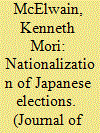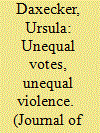|
|
|
Sort Order |
|
|
|
Items / Page
|
|
|
|
|
|
|
| Srl | Item |
| 1 |
ID:
117074


|
|
|
|
|
| Publication |
2012.
|
| Summary/Abstract |
The postwar electoral dominance of the Liberal Democratic Party (LDP) was founded on (1) strong incumbency advantage, which insulated its legislators from declining party popularity, and (2) the malapportionment of districts, which overvalued the electoral clout of the party's rural base. The LDP's demise in 2009 was due to the reversal of both factors, each of which was related to electoral reforms in the 1990s. First, I demonstrate that elections are becoming more "nationalized," due to the growing weight that voters attach to the attractiveness of party leaders. Past performance has become a poorer predictor of incumbent reelection, giving way to large partisan swings that are increasingly correlated across districts. Second, malapportionment was reduced by almost half in 1994, meaning that rural votes are now worth fewer seats. As a result, parties that can attract swing voters nationally are better positioned for victory than those with a narrow regional base.
|
|
|
|
|
|
|
|
|
|
|
|
|
|
|
|
| 2 |
ID:
170811


|
|
|
|
|
| Summary/Abstract |
Elections held outside of advanced, industrialized democracies can turn violent because elites use coercion to demobilize political opponents. The literature has established that closely contested elections are associated with more violence. I depart from this emphasis on competitiveness by highlighting how institutional biases in electoral systems, in particular uneven apportionment, affect incentives for violence. Malapportionment refers to a discrepancy between the share of legislative seats and the share of population, violating the ‘one person, one vote’ principle. Drawing on recent work on malapportionment establishing that overrepresented districts are targeted with clientelist strategies, are more homogenous, and are biased in favor of district-level incumbent parties, I argue that overrepresented districts present fewer incentives for using violence. In contrast, elites in well-apportioned or underrepresented districts exert less control over electoral outcomes because such districts have more heterogenous voter preferences, raising incumbent and opposition demands to employ violence. I examine the effects of malapportionment on violence using constituency-level elections data and new, disaggregated, and geocoded event data on the incidence of election violence in India. Results from six parliamentary elections from 1991 to 2009 show that electoral violence is less prevalent in overrepresented constituencies, and that violence increases in equally apportioned and moderately underrepresented districts. The analysis establishes additional observable implications of the argument for district voter homogeneity and incumbent victory, accounts for confounders such as urbanization and state-level partisanship, and validates measures of election violence. The findings illustrate that institutional biases shape incentives for electoral violence.
|
|
|
|
|
|
|
|
|
|
|
|
|
|
|
|
|
|
|
|
|